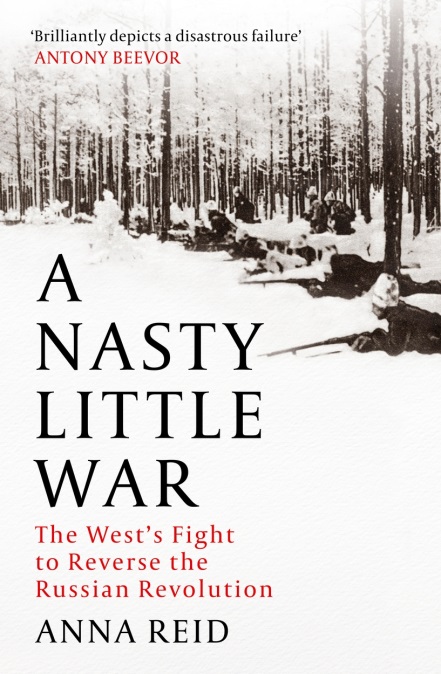Anna Reid: A Nasty Little War - The West's Fight to Reverse the Russian Revolution review - home truths | reviews, news & interviews
Anna Reid: A Nasty Little War - The West's Fight to Reverse the Russian Revolution review - home truths
Anna Reid: A Nasty Little War - The West's Fight to Reverse the Russian Revolution review - home truths
Reid brings to light a war the West has tried its best to forget

During the Cold War, US presidents often claimed that the West and the Soviet Union had never fought one another directly. This observation made sense geopolitically – the likelihood of mutually assured destruction made a nuclear conflict seem unthinkable – but it wasn’t strictly true.
It was untrue because it overlooked the Allied intervention in the Russian Civil War of 1918-20, which the British even more than the Americans had plenty of reasons to forget. “It was an uncomfortable business really,” recalled Christopher Bilney, who served as a seaplane pilot in the Caucasus. “A really nasty, dirty little war...Waste of time, money and everything else.”
Ignominious failure and betrayal were the main reasons why this particular military episode was all but erased from history. History is usually written by the winners, after all. Yet, in a sense, the West’s involvement in the conflict was always doomed to fail because it lacked a clear objective. It also lacked resources and troop numbers, both of which were laughably inadequate for the task of invading a country as vast and inhospitable as Russia.
The intervention began more or less accidentally as a result of the overthrow of the House of Romanov. Tsarist Russia had been fighting on the Allied side in World War One until the October Revolution of 1917. But once the Bolsheviks signed the peace treaty of Brest-Litovsk in March the following year, the Germans were able to occupy what is now Ukraine and Baltic republics, cutting off Allied forces that were now trapped inside Russia.
 In order to prevent key ports and matériel falling into the Kaiser’s hands, the Allied powers occupied Murmansk in the west and Vladivostok in the east, as well as Crimea in the south. It was only later in the year, following the November armistice and a long-expected anti-Bolshevik uprising by former officers in the Tsarist army, that the Western battleplan changed to backing these counter-revolutionary forces, known as the “Whites”.
In order to prevent key ports and matériel falling into the Kaiser’s hands, the Allied powers occupied Murmansk in the west and Vladivostok in the east, as well as Crimea in the south. It was only later in the year, following the November armistice and a long-expected anti-Bolshevik uprising by former officers in the Tsarist army, that the Western battleplan changed to backing these counter-revolutionary forces, known as the “Whites”.
It was a little war in the sense that it was inevitably short-lived – and nasty on account of widespread anti-semitic atrocities perpetrated across Ukraine by Whites, Poles and Ukrainian nationalists, to which Allied commanders mostly turned a blind eye.
Yet, as Anna Reid points out in A Nasty Little War, racism of one kind or another was a ubiquitous feature of the conflict. Not only was anti-semitism a staple of White propaganda, with Bolshevik leaders like Trotsky routinely denoted by their Jewish birth-names (Bronstein-Trotsky) and caricatured as devils with Stars of David around their necks. A British information sheet handed out to newly arrived American troops included a section on the “Russian Character”, with tips on dealing with the locals: “Generally speaking, the Russian is exactly like a child – inquisitive, easily gulled, easily offended.”
Even Winston Churchill, the war’s loudest cheerleader, informed the British cabinet in December 1918 that Russia was “a very large country, a very old country, a very disagreeable country, inhabited by immense numbers of ignorant people”. The Soviet enemy, in particular, was almost subhuman, or so he told the voters in his Dundee constituency at the same month’s general election: “Russia is being rapidly reduced by the Bolsheviks to an animal form of barbarism. […] Civilisation is being completely extinguished over gigantic areas, while the Bolsheviks hop and caper like troops of ferocious baboons amid the ruins of cities and the corpses of their victims.”
Reid, author of Borderland: A Journey through the History of Ukraine (1997) as well as two books on Russia, describes the encounter with anti-Jewish pogroms of the civil war as “one of the most jolting aspects of researching this book”. Her use of diaries, letters and memoirs, mainly British, highlights the shameful fact that Ukrainian and Polish nationalist acts of violence – and Reid estimates the death toll from pogroms at “between 100,000 and 200,000” – were tacitly condoned (or at least downplayed) by Allied commanders.
She tries to draw an historical lesson from the disastrous failure of the Allied intervention in the Russian civil war: “With Putin’s full-scale invasion of Ukraine, history is in some ways repeating itself. Again, the West is sending weapons and money; again, it has imposed economic sanctions; again middle-class Russians are fleeing into exile. Most of all, Russia is again in the grip of a millennial ideology, its leaders denying that Ukraine exists.”
Yet, on a more optimistic note, she suggests that the lesson of the intervention is that "Putin will ultimately fail for the same reason the Whites did: because his regime is brutal and corrupt, because he has no political programme beyond nostalgia for past glories, and most of all because he cannot accept that the non-Russian nationalities do not want to return to Moscow’s rule."
- A Nasty Little War: The West’s Fight to Reverse the Russian Revolution by Anna Reid (John Murray, £25)
- More book reviews on theartsdesk
The future of Arts Journalism
You can stop theartsdesk.com closing!
We urgently need financing to survive. Our fundraising drive has thus far raised £49,000 but we need to reach £100,000 or we will be forced to close. Please contribute here: https://gofund.me/c3f6033d
And if you can forward this information to anyone who might assist, we’d be grateful.

Subscribe to theartsdesk.com
Thank you for continuing to read our work on theartsdesk.com. For unlimited access to every article in its entirety, including our archive of more than 15,000 pieces, we're asking for £5 per month or £40 per year. We feel it's a very good deal, and hope you do too.
To take a subscription now simply click here.
And if you're looking for that extra gift for a friend or family member, why not treat them to a theartsdesk.com gift subscription?
more Books
 'We are bowled over!' Thank you for your messages of love and support
Much-appreciated words of commendation from readers and the cultural community
'We are bowled over!' Thank you for your messages of love and support
Much-appreciated words of commendation from readers and the cultural community
 Thomas Pynchon - Shadow Ticket review - pulp diction
Thomas Pynchon's latest (and possibly last) book is fun - for a while
Thomas Pynchon - Shadow Ticket review - pulp diction
Thomas Pynchon's latest (and possibly last) book is fun - for a while
 Justin Lewis: Into the Groove review - fun and fact-filled trip through Eighties pop
Month by month journey through a decade gives insights into ordinary people’s lives
Justin Lewis: Into the Groove review - fun and fact-filled trip through Eighties pop
Month by month journey through a decade gives insights into ordinary people’s lives
 Joanna Pocock: Greyhound review - on the road again
A writer retraces her steps to furrow a deeper path through modern America
Joanna Pocock: Greyhound review - on the road again
A writer retraces her steps to furrow a deeper path through modern America
 Mark Hussey: Mrs Dalloway - Biography of a Novel review - echoes across crises
On the centenary of the work's publication an insightful book shows its prescience
Mark Hussey: Mrs Dalloway - Biography of a Novel review - echoes across crises
On the centenary of the work's publication an insightful book shows its prescience
 Frances Wilson: Electric Spark - The Enigma of Muriel Spark review - the matter of fact
Frances Wilson employs her full artistic power to keep pace with Spark’s fantastic and fugitive life
Frances Wilson: Electric Spark - The Enigma of Muriel Spark review - the matter of fact
Frances Wilson employs her full artistic power to keep pace with Spark’s fantastic and fugitive life
 Elizabeth Alker: Everything We Do is Music review - Prokofiev goes pop
A compelling journey into a surprising musical kinship
Elizabeth Alker: Everything We Do is Music review - Prokofiev goes pop
A compelling journey into a surprising musical kinship
 Natalia Ginzburg: The City and the House review - a dying art
Dick Davis renders this analogue love-letter in polyphonic English
Natalia Ginzburg: The City and the House review - a dying art
Dick Davis renders this analogue love-letter in polyphonic English
 Tom Raworth: Cancer review - truthfulness
A 'lost' book reconfirms Raworth’s legacy as one of the great lyric poets
Tom Raworth: Cancer review - truthfulness
A 'lost' book reconfirms Raworth’s legacy as one of the great lyric poets
 Ian Leslie: John and Paul - A Love Story in Songs review - help!
Ian Leslie loses himself in amateur psychology, and fatally misreads The Beatles
Ian Leslie: John and Paul - A Love Story in Songs review - help!
Ian Leslie loses himself in amateur psychology, and fatally misreads The Beatles
 Samuel Arbesman: The Magic of Code review - the spark ages
A wide-eyed take on our digital world can’t quite dispel the dangers
Samuel Arbesman: The Magic of Code review - the spark ages
A wide-eyed take on our digital world can’t quite dispel the dangers
 Zsuzsanna Gahse: Mountainish review - seeking refuge
Notes on danger and dialogue in the shadow of the Swiss Alps
Zsuzsanna Gahse: Mountainish review - seeking refuge
Notes on danger and dialogue in the shadow of the Swiss Alps

Add comment